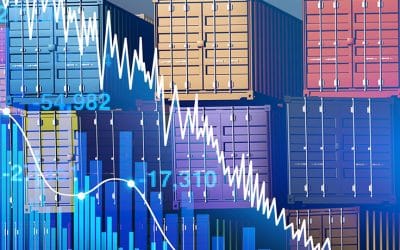Global risks: toward an even more uncertain second half of the year

Redacción Mapfre
The latest data collected by experts indicate that the global economy is close to experiencing a recession shock, something unthinkable just a few months ago. Geopolitical conflict and the second-round effects it has caused have aggravated forecasts not just for this year, but also for 2023. The great unknown surrounding estimates is how long the war in Ukraine will last.
However, this is not the only risk facing regions in the coming months: the most recent ‘Economic and Industry Outlook: Perspectives on the Third Quarter’ report, prepared by MAPFRE Economics, breaks down a landing with up to seven cross winds, four of which have intensified.
Global Governance and Geopolitical Crisis
According to the report, global geopolitical tensions have reached a new phase marked by deadlock in the conflict inside and outside of Ukraine. The NATO meeting in Madrid “served to establish common positions and mark new borders in the East/West fragmentation (new membership of Sweden and Finland), while the NATO discourse deeply troubled China, as it views it as a structural threat.”
In Europe, the Economic Research experts underline that political weakness is once again at the fore in Italy and France, which somewhat weakens Europe’s common position strategically and structurally on matters such as “energy reform, relations with Russia, and anti-fragmentation mechanisms,” among others. The United States, for its part, is suffering on multiple fronts such as inflation, growing economic sluggishness, and insecurity, which are taking a toll on Joe Biden’s popularity and could, according to the report, “be laying the foundation for a future president who is less friendly toward Europe, which would be an important setback for the current strategic direction.”
Global debt
Another emerging risk, which is of great concern, is global debt, which increased by 3 billion dollars during the first quarter of 2022, reaching a new record of 305 trillion.
While developed markets performed better (with debt decreasing by 20 pp from maximums, and with financial companies and the public sector leading on deleveraging), emerging markets reduced their ratio by only 6 pp from maximums. According to the report, this slower rate is due “to China (whose governmental debt continued to increase) and to a context of higher interest rates and in response to a hardening of monetary policy in the developed world.”
Economic policy
As the inflationary trend gains traction, with an unchanged geopolitical context and supply still restricted, “agents’ expectations are positioned toward greater salary demands to mitigate the effects of the loss of purchasing power,” the experts explain. Therefore, the main central banks are reinforcing their postures of restrictive monetary policy to comply with their respective mandates, “either their unique mandate or because the price stability factor prevails.”
In this regard, MAPFRE Economic Research anticipates greater slowdown of consumption and that companies will find greater obstacles to hiring, in line with the soft landing expected by central planners. While this is the main scenario, the risk of crossing the threshold of neutrality toward restriction could exacerbate the process and result in a hard landing that would prematurely end the adjustment cycle.
In both scenarios, the monetary and fiscal response in many economies could be more limited than in the past, “given the high levels of debt accumulated in recent years on central banks’ balance sheets and established deficits with a large integrated structural component,” they say.
Sovereign-financial crisis in China
As China’s reopening gains traction, its activity indicators are recovering, which provides some shock absorption for the recovery of both activity and global supply chains, although with nuances. On the one hand, Economic Research says that the details of the high-frequency indicators show that “the reactivation is intense,” although it will take a bit longer than initially forecast to reach full capacity. On the other hand, with regard to Covid-19 policies, concerns remain surrounding the uncertainty of future lockdowns in response to new outbreaks. As a result, supply chains continue to rotate toward southeast Asia in search of greater stability; although this could relieve supply problems in the short term, these supply chains “still need time to prosper, consolidate, and become integrated into the global mechanism,” it recognizes.
In the geopolitical sphere, in addition to China's ambiguous geopolitical positioning regarding the Russia conflict and its ambitions for Taiwan, there is a degree of internal alarm at ever-closer ties between NATO and Asian-Pacific countries. With the development of these multilateral networks, the conflict of interest between China and countries such as Japan, South Korea, Australia, and New Zealand could add an additional risk to the already complicated geopolitical chessboard. On the positive side, in the interest of revitalizing availably supply, the report notes that the US may relax “some of the sanctions that Joe Biden’s administration inherited from his predecessor, which could provide an additional boost to global trade.”
Climate change
The environmental issue is inherently linked to the changes that are occurring around the globe. However, with the crisis in Ukraine, the dichotomy between energy security and an orderly transition has been brought to the fore. In the current situation, our dependence on fossil fuels (whether Russian or not) in the short term presents a global energy challenge, particularly in Europe. “Although this geopolitical event will drive investment in clean energy (thereby reducing dependence on traditional energy sources in search of greater energy security), in the short term, the reorganization of the sources of fossil fuel production to cover the most immediate need has become a strategic imperative, as the risks of a lack of supply increase and the risk of economies coming to a standstill is setting off alarm bells in several countries,” they note.
Inflation
The recent acceleration in inflation rates continues to surprise both financial markets and the managers of monetary policy in their work to control expectations under the objectives of their mandates.
As such, the risk of de-anchoring increases, and central banks’ will to act becomes more active. In the United States (as a point of reference), additional indicators such as surveys from the University of Michigan “have begun to indicate a de-anchoring of expectations to the upside, which would lead central banks to continue orienting their decisions toward a restrictive policy to shift expectations, to the detriment of activity and employment figures,” the Outlook report details.
A second point of view of this de-anchoring of expectations to the upside, analyzed by MAPFRE Economic Research, is starting to be seen in salary negotiations. The most recent dynamic is being reflected in higher salary negotiations that are increasingly common in several countries (Germany, France, Netherlands). In this regard, the current price setting process is already changing expectations, with a deregulation of margins for the end consumer which, in its most recent phase, is beginning to permeate salary demand.
Covid-19
According to previous experience in Europe and the northeast United States, the second Omicron wave (which has seen a generalized increase in cases but with minimum deaths), caused by a relaxation of behavior, decreased mask use, and the Omicron sub-variants, is expected to last a few more weeks. Meanwhile, through strict lockdowns, China has successfully implemented a zero-Covid-19 strategy, which MAPFRE Economics forecasts will continue until at least October 1.



